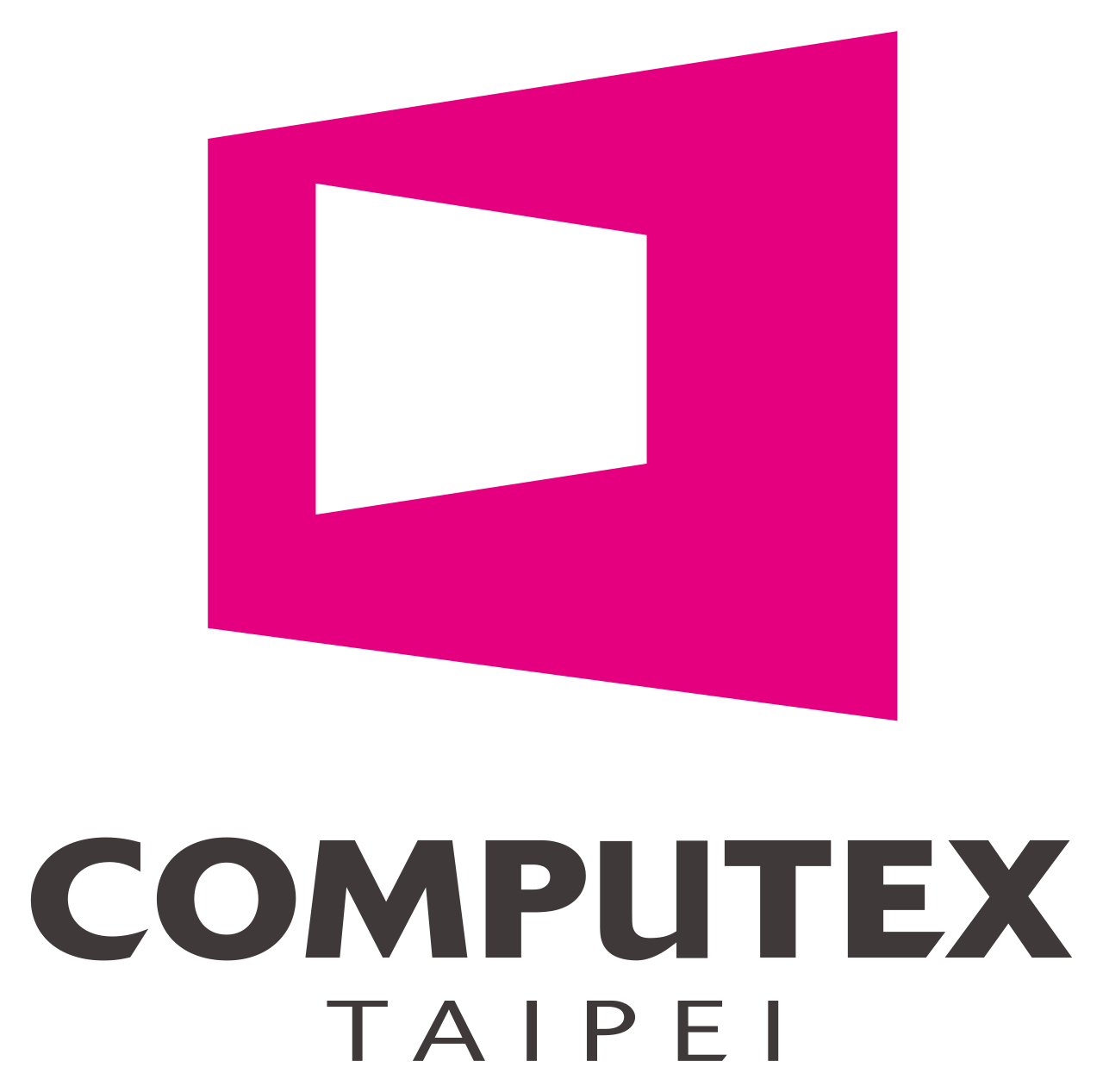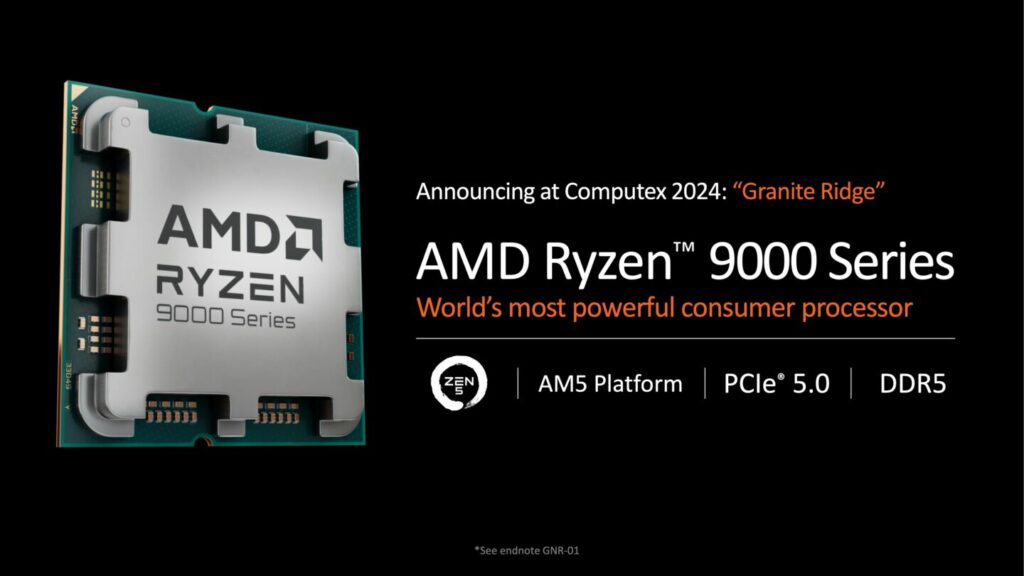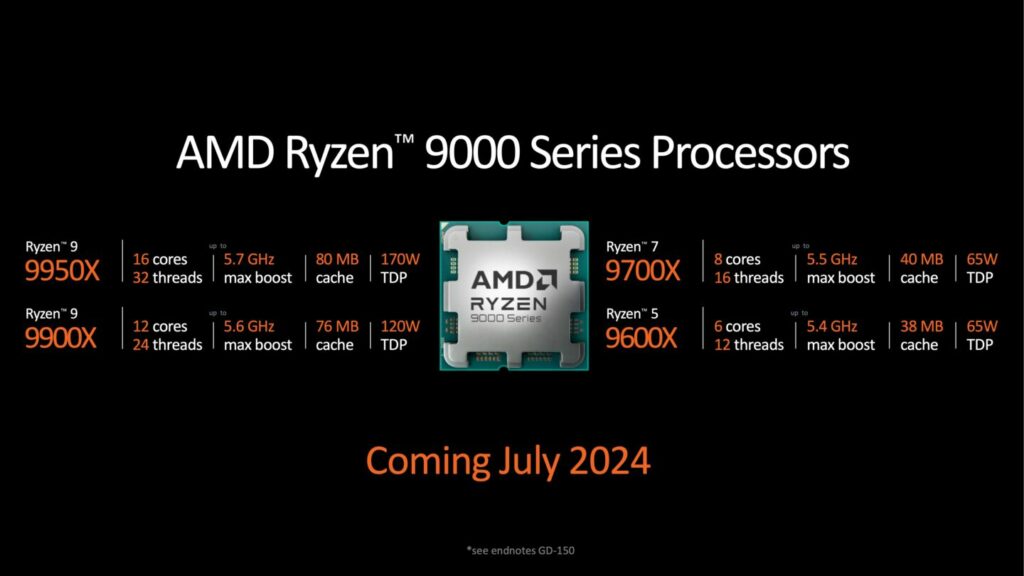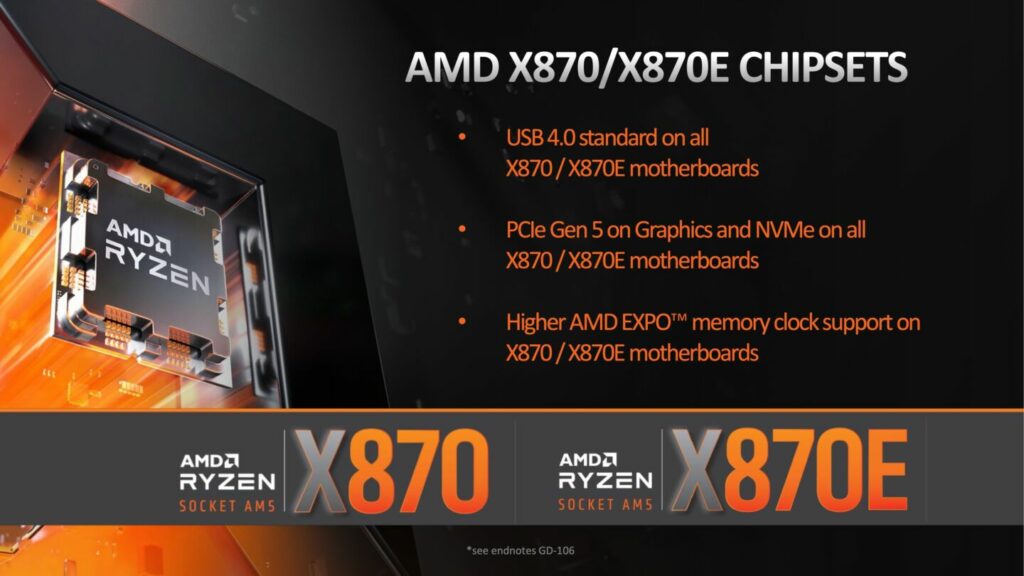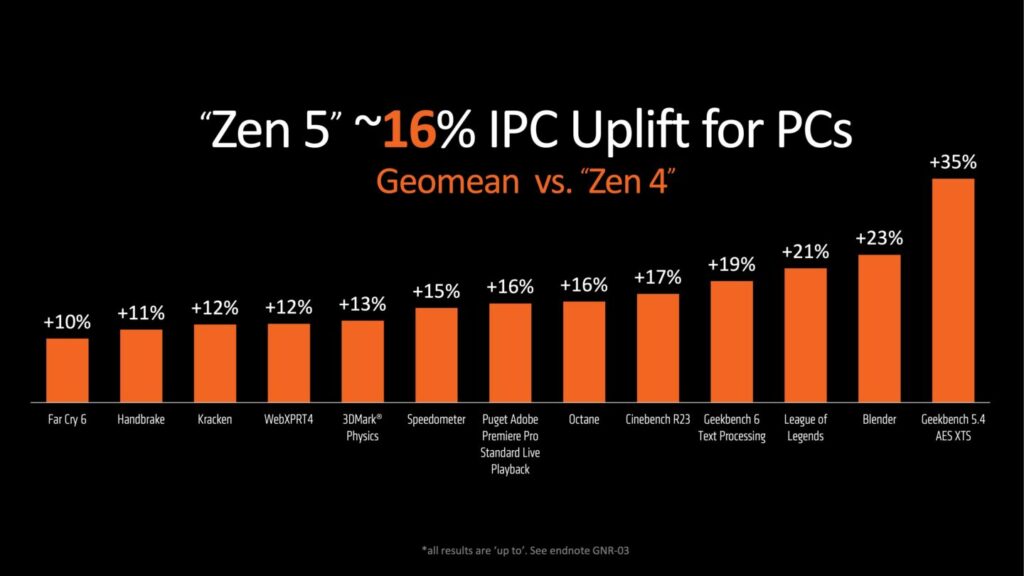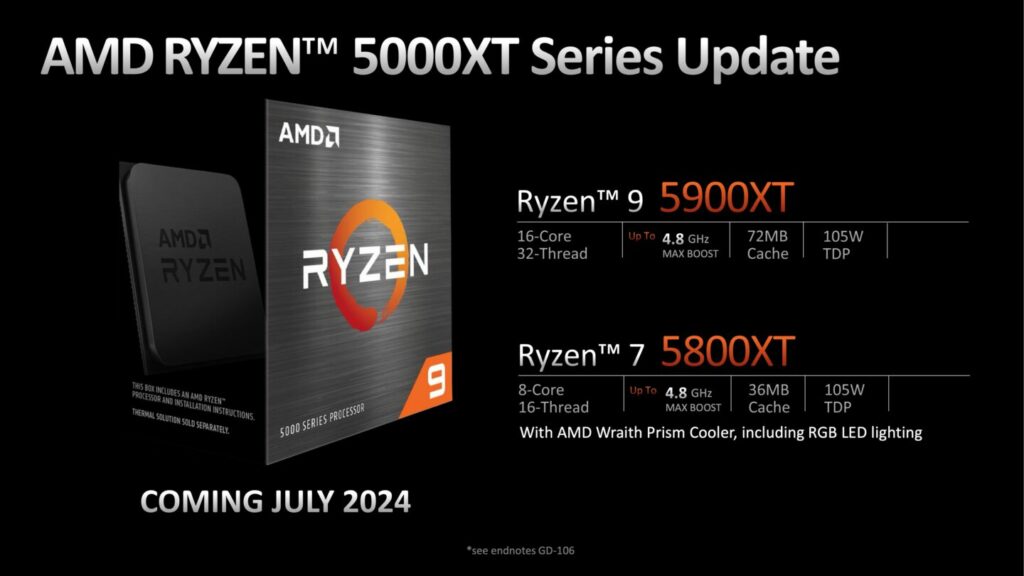Computex 2024 Coverage
As reported by Forbes,
With an impressive lineup of over 20 launch laptops featuring the new Snapdragon X Elite CPU, including the Dell XPS 13, Qualcomm’s bullish attitude to this year’s Computex Trade show is also backed up by some impressive benchmarks with its Windows-based laptops due for release in the next few weeks.
The likes of Acer, Asus, Dell, HP, Lenovo, Microsoft and Samsung are all onboard with extremely thin and light laptop models with premium models such as Dell’s premium XPS 13 using the new Qualcomm Snapdragon X Elite CPU, while in the past the likes of Intel have dominated its XPS range. The reason? The new CPU promises more performance and far greater battery life in a range of applications, even gaming and content creation, with more than 24 hours between charges in many cases.
The ARM-derived CPU features a Qualcomm Oryon 12-core CPU, Adreno GPU and Hexagon NPU with 45 TOPS, with some of the 20 plus laptops offering slightly lower core counts. The NPU or neural processing unit, which is designed from the ground up for generative AI tasks using a mix of heterogeneous processors, it’s this part that’s generating the headlines.
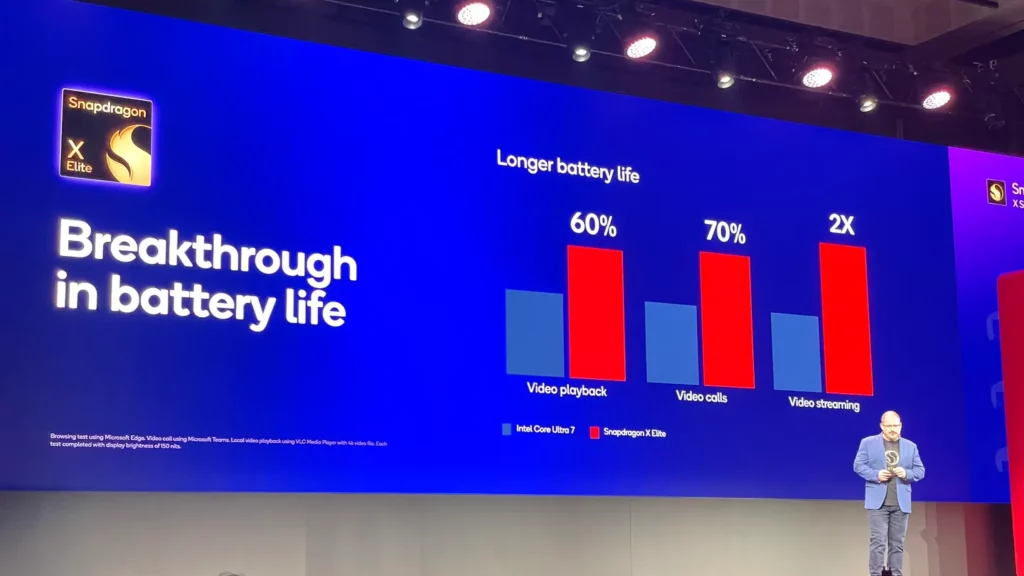
On show at Qualcomm’s various demos at Computex were some impressive benchmarks, with performances advantages over the likes of AMD’s Ryzen 9 7940HS and Intel’s Core Ultra 9 185H of up to a claimed 51%, all while using up to 65% less power, which would back up the claims of battery life lasting well over a day in many cases.
The demos also seem to back up the performance claims, where there was particular interest in gaming and content creation. Starting with the former, there were examples of several popular games running at 1080p resolution at well over 30fps, especially as the GPU portion of the Snapdragon X Elite supports frame-rate boosting FSR as well. However, Qualcomm did state that its goals for now are not to create laptops for hard core gamers, but those that would be classed as casual gamers, who currently use mobile devices equipped with integrated graphics or low end discrete GPUs.
Snapdragon X Elite also accelerates content creation software such as Adobe Premiere Pro and Photoshop as well as DaVinci Resolve, making it particularly attractive to those that edit videos on the go, but don’t want the added weight or power drain of a discrete GPU in their laptop.
The AI features were just as impressive, with an app called DJ Pro able to separate different sounds in music such as vocals or bass in real time using the Hexagon neural processor.
Qualcomm isn’t short of support from laptop manufacturers either and even Dell has seen fit to use the X Elite in its flagship sub 15 inch model, the XPS 13, with the XPS range traditionally using either Intel or AMD CPUs. The 22 new laptops will start arriving from 22nd June and all eyes will be on reviewers to see how they stack up against the competition.
As reported by Ars Technica,
It’s been almost two years since AMD introduced its Ryzen 7000 series desktop CPUs and the Zen 4 CPU architecture. Today, AMD is announcing the first concrete details about their successors. The Ryzen 9000 CPUs begin shipping in July.
At a high level, the Ryzen 9000 series and Zen 5 architecture offer mostly incremental improvements over Ryzen 7000 (Ryzen 8000 on the desktop is used exclusively for Zen 4-based G-series CPUs with more powerful integrated GPUs). AMD says that Zen 5 is roughly 16 percent faster than Zen 4 at the same clock speeds, depending on the workload—certainly not nothing, and there are some workloads that perform much better. But that number is far short of the 29 percent jump between Zen 3 and Zen 4.
AMD and Intel have both compensated for mild single-core performance improvements in the past by adding more cores, but Ryzen 9000 doesn’t do that. From the 9600X to the 9950X, the chips offer between 6 and 16 full-size Zen 5 cores, the same as every desktop lineup since Zen 2 and the Ryzen 3000 series. De-lidded shots of the processors indicate that they’re still using a total of two or three separate chiplets: one or two CPU chiplets with up to 8 cores each, and a separate I/O die to handle connectivity. The CPU chiplets are manufactured on a TSMC N4 process, an upgrade from the 5nm process used for Ryzen 7000, while the I/O die is still made with a 6nm TSMC process.
These chips include no Zen 5c E-cores, as older rumors suggested. Zen 5c is a version of Zen 5 that is optimized to take up less space in a silicon die, at the expense of higher clock speeds; Zen 5c cores are making their debut in the Ryzen AI 300-series laptop chips AMD also announced today. Boosting the number of E-cores has helped Intel match and surpass AMD’s multi-core performance, though Ryzen’s power consumption and efficiency have both outdone Intel’s throughout the 12th-, 13th-, and 14th-generation Core product cycles. Apple also uses a mix of P-cores and E-cores in its high-end desktop CPU designs.
Ryzen 9000 doesn’t include any kind of neural processing unit (NPU), nor does AMD mention whether the Ryzen 7000’s RDNA 2-based integrated GPU has been upgraded or improved.
AMD is also announcing new X870 and X870E motherboard chipsets to accompany the new processors; as with the X670, the E-series chipset is actually a pair of chipsets on the same motherboard, boosting the number of available USB ports, M.2 slots, and PCIe slots.
The only real improvement here seems to be that all X870-series boards support USB4 and higher EXPO memory overclocking speeds by default. The chipsets also support PCIe 5.0 speeds for the main PCIe slot and M.2 slot, though the X670 chipsets already did this.
The processors’ power requirements aren’t changing, so users with 600-series motherboards ought to be able to use Ryzen 9000 CPUs with little to no performance penalty following a BIOS update.
Ryzen 9000 doesn’t seem likely to resolve the biggest issues with the AM5 platform, namely the high costs relative to current-gen Intel systems, the high cost relative to AM4-based systems today, and even the high cost relative to AM4-based systems at the same point in the AM4 socket’s lifespan. Motherboards remain more expensive, DDR5 memory remains more expensive, and there are still no AM5 processors available for significantly less than $200.
According to AMD’s own timeline, it plans to keep the AM4 socket around until at least 2025. AM4 is still a surprisingly decent budget platform given that the socket was introduced eight years ago, and AMD does, in fact, continue to trickle out new Ryzen 5000-series CPUs to give buyers and upgrades more options. But it still means that system builders either need to choose between an expensive platform that has a future or a cheaper platform that’s more or less a dead end.
As reported by ANandTech,
Intel is lifting the lid on some of the finer architectural and technical details about its upcoming Lunar Lake SoC – the chip that will be the next generation of Core Ultra mobile processors. Once again holding one of their increasingly regular Tech Tour events for media and analysts, Intel this time set up shop in Taipei just before the beginning of Computex 2024. During the Tech Tour, Intel disclosed numerous facets of Lunar Lake, including their new P-Core design codenamed Lion Cove and a new wave of E-cores that are a bit more like Meteor Lake’s pioneering Low Power Island E-Cores. Also disclosed was the Intel NPU 4, which Intel claims delivers up to 48 TOPS, surpassing Microsoft’s Copilot+ requirements for the new age of AI PCs.
Intel’s Lunar Lake represents a strategic evolution in their mobile SoC lineup, building on their Meteor Lake launch last year, focusing on enhancing power efficiency and optimizing performance across the board. Lunar Lake dynamically allocates tasks to efficient cores (E-cores) or performance cores (P-cores) based on workload demands by leveraging advanced scheduling mechanisms, which are assigned to ensure optimal power usage and performance. Still, once again, Intel Thread Director, along with Windows 11, plays a pivotal role in this process, guiding the OS scheduler to make real-time adjustments that balance efficiency with computational power depending on the intensity of the workload.
While there are many aspects of Lunar Lake to dive into, perhaps it’s best we start with what’s sure to be the most eye-catching: who’s building it.
Intel’s Lunar Lake tiles are not being fabbed using any of their own foundry facilities – a sharp departure from historical precedence, and even the recent Meteor Lake, where the compute tile was made using the Intel 4 process. Instead, both tiles of the disaggregated Lunar Lake are being fabbed over at TSMC, using a mix of TSMC’s N3B and N6 processes. In 2021 Intel set about freeing their chip design groups to use the best foundry they could – be it internal or external – and there’s no place that’s more apparent than here.
Overall, Lunar Lake represents their second generation of disaggregated SoC architecture for the mobile market, replacing the Meteor Lake architecture in the lower-end space. At this time, Intel has disclosed that it uses a 4P+4E (8 core) design, with hyper-threading/SMT disabled, so the total thread count supported by the processor is simply the number of CPU cores, e.g., 4P+4E/8T.
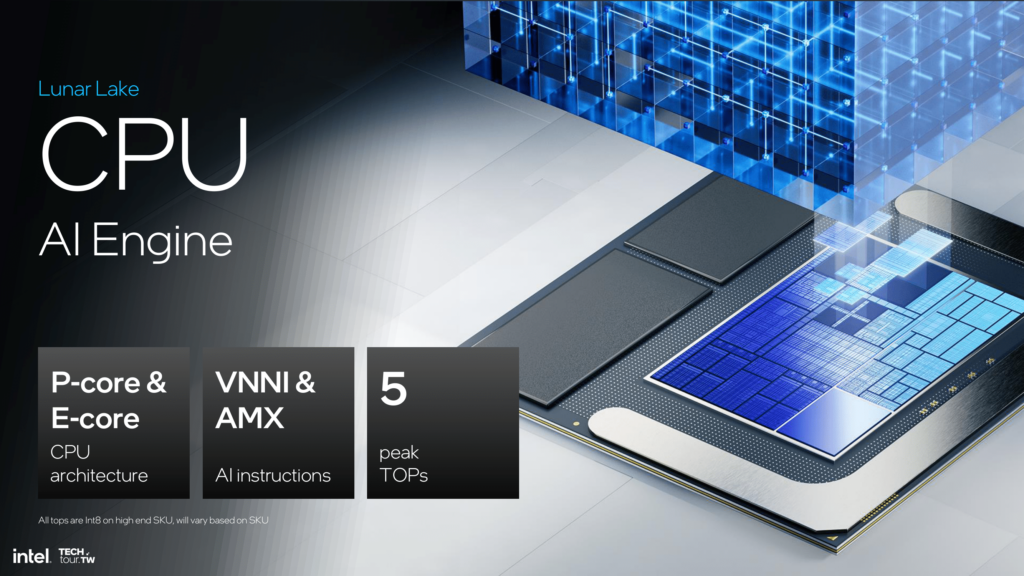
The build-up of Lunar Lake combines a synergetic collaboration between Intel’s architectural design team and TSMC’s manufacturing process nodes to bring the latest Lion Cove P-cores to Lunar Lake, which boosts Intel’s architectural IPC as you would expect from a new generation. At the same time, Intel also introduces the Skymont E-cores, which replace the Low Power Island Cresmont E-cores of Meteor Lake. Notably, however, these E-cores don’t connect to the ring bus like the P-cores, which makes them a sort of hybrid LP E-core, combining the efficiency gains of the more advanced TSMC N3B node with the double-digit gains in IPC over the previous Crestmont cores.
The entire compute tile, including the P and E-cores, is built on TSMC’s N3B node, while the SoC tile is made using the TSMC N6 node.
At a higher level, Intel is once again using their Foveros packaging technology here. Both the compute and SoC (now the “Platform Controller”) tiles sit on top of a base tile, which provides high-speed/low-power routing between the tiles, and further connectivity to the rest of the chip and beyond.
In another first for a mainstream Intel Core product, the Lunar Lake SoC platform also includes up to 32 GB of LPDDR5X memory on the chip package itself. This is arranged as a pair of 64-bit memory chips, offering a total 128-bit memory interface. As with other vendors using on-package memory, this change means that users can’t just upgrade DRAM at-will, and the memory configurations for Lunar Lake will ultimately be determined by what SKUs Intel opts to ship.
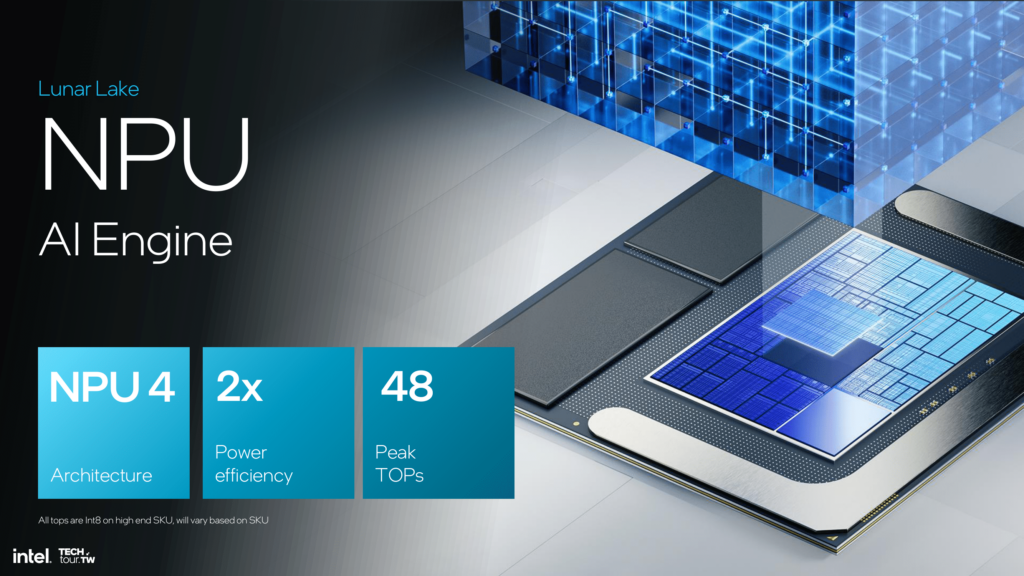
With Lunar Lake, Intel is also strongly focusing on AI, as the architecture integrates a new NPU called NPU 4. This NPU is rated for up to 48 TOPS of INT8 performance, thus making it Microsoft Copilot+ AI PC ready. This is the bar all of the PC SoC vendors are aiming for, including AMD and Qualcomm too.
Intel’s integrated GPU will also be a contributing player here. While not the highly efficient machine that the dedicated NPU is, the Arc Xe2-LPG brings dozens of additional T(FL)OPS of performance with it, and some additional flexibility an NPU doesn’t come with. Which is why you’ll also see Intel rating the performance of these chips in terms of total platform TOPS – in this case, 120 TOPS.
Intel’s collaboration with Microsoft further enhances workload management through the fabled Intel Thread Director, optimized for applications such as the Copilot assistant. Given the time of the introduction of Lunar Lake, it somewhat sets the stage for a Q3 2024 launch, which coincides with the holiday 2024 market.
To say that energy efficiency is a key goal for Lunar Lake would be an understatement. For as much as Intel is riding high in the mobile PC CPU market (AMD’s share there is still but a fraction), the company has been feeling the pressure over the last few years from customer-turned-rival Apple, whose M-series Apple Silicon has been setting the bar for power efficiency over the last few years. And now with Qualcomm attempting to do the same things for the Windows ecosystem with their forthcoming Snapdragon X chips, Intel is preparing to make their own power play.
Intel’s Thread Director and power management updates for Lunar Lake show various and significant improvements compared to Meteor Lake. The Thread Director uses a heterogeneous scheduling policy, initially assigning tasks to a single E-core and expanding to other E-cores or P-cores as and when needed. OS containment zones are designed to limit tasks to specific cores, which directly improves power efficiency and delivers the performance needed by the right core for the workload at hand. Integration with power management systems and a quad array of Power Management Controllers (PMC) further allows the chip, in concert with Windows 11, to make context-aware adjustments, ensuring optimal performance with minimal power usage and wastage.
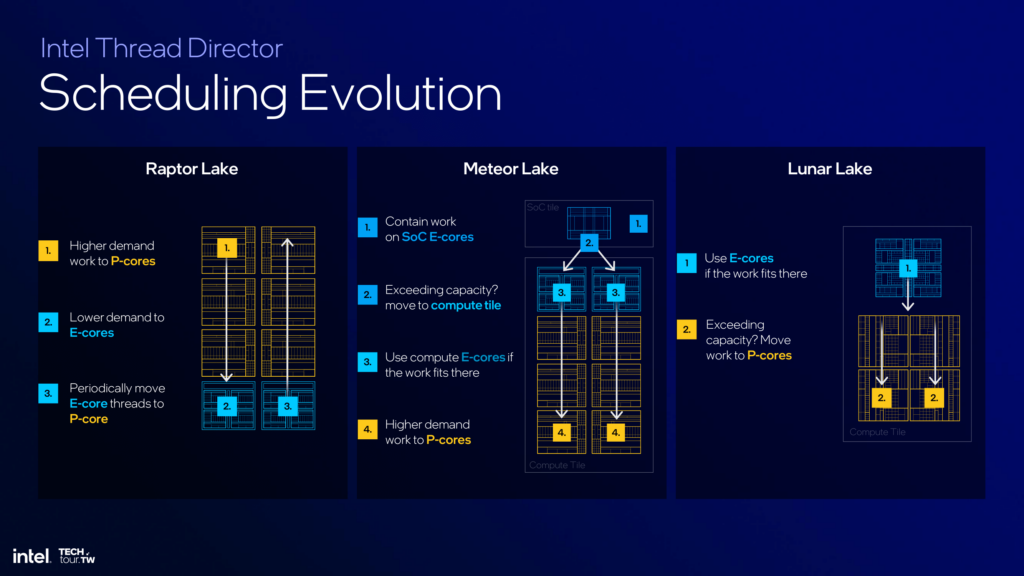
Lunar Lake’s scheduling strategy effectively handles power-sensitive applications. One example Intel gave is that video conferencing tasks are kept within the efficiency core cluster, utilizing the E-cores to maintain performance while reducing power consumption by up to 35%, as shown by Intel’s provided data. These improvements are achieved through collaboration with OS developers such as Microsoft for seamless integration for optimizing for the best balance between power consumption and performance.
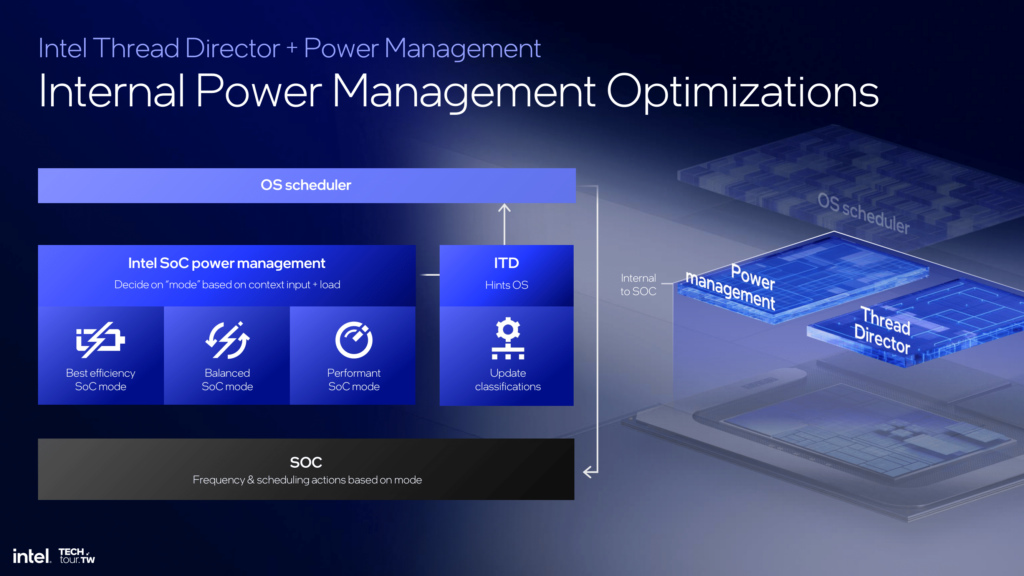
Focusing on the power management system for Lunar Lake, Intel uses its SoC power management, operating in efficiency, balance, and performance modes tailored and designed to adapt to whatever the demands of the workload at the time of operation. This multi-layered approach allows the Lunar Lake SoC to operate efficiently. Again, much like the Intel Thread Director, the PMCs can balance power usage with performance needs.
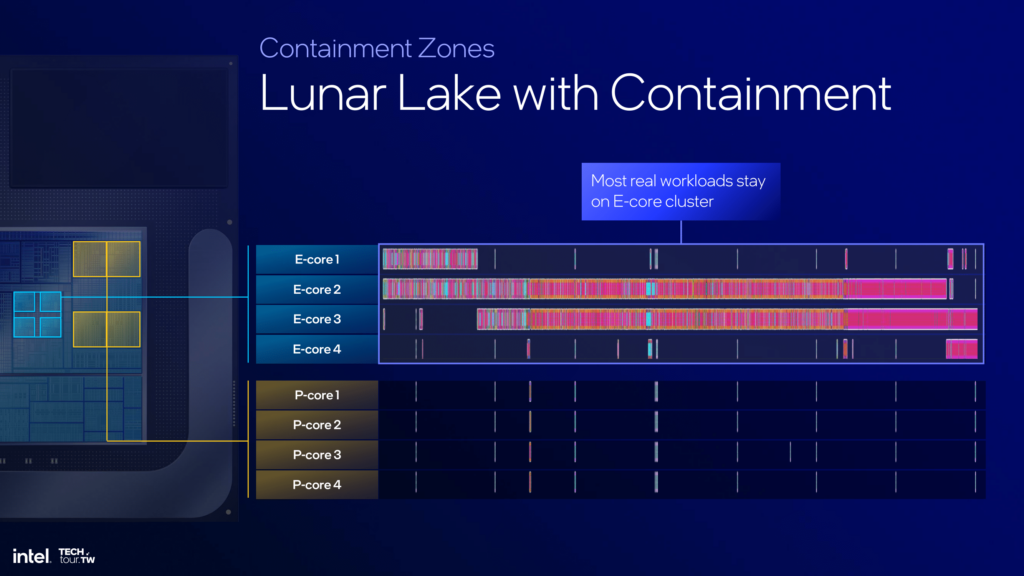
Intel further plans to enhance the Thread Director by increasing scenario granularity, implementing AI-based scheduling hints, and enabling cross-IP scheduling within Windows 11. These enhancements essentially equate to workload management designed to boost overall power efficiency and deliver performance across various applications when needed without wasting power budget by allocating lighter tasks to the higher power P-cores.
As reported by Engadget,

If you’ve ever wanted an AI assistant to make sure your PC is optimized for whatever game you’re playing, NVIDIA may have the answer. The company is showing off a new demo called G-Assist, a GeForce-powered AI chatbot that might one day help reduce the more tedious aspects of gaming.
G-Assist performs a couple of key functions around both setup and directly in games. In a demo running inside ARK: Survival Ascended, NVIDIA shows it answering queries like “what’s the next early game weapon and where do I find the crafting materials for it.” In response, it points out that the best one is a spear and describes how to gather wood, flint and fiber to make one.
Some purists might see that as cheating, but another G-Assist tool looks to be less ethically fraught. If you ask it to optimize settings for a game like Cyberpunk 2077, it can do things like directly apply the highest quality graphics settings. It can also analyze your system as a whole and recommend changes like boosting your 4K monitor refresh rate from 60Hz to 144Hz.
NVIDIA has used the G-Assist name before for a 2017 April Fool’s joke, saying the AI would play games for you in “Ghostplay” mode while you went to pay for a pizza at the door. The new G-Assist can’t do that, but it could still be helpful by eliminating the busywork needed for system optimization. It’s just a demonstration for now, but NVIDIA is actively signing up developers interested in learning more about the project.
Other News
As reported by Windows Central,
Microsoft announced it is addressing a recent backlash around Windows Recall, its controversial forthcoming AI-powered search service that works by taking a snapshot of your PC every 5 seconds.
Recently, it was discovered that the feature stores data unencrypted on the device. The company says it will ensure Windows Recall data is safe by employing “just-in-time” protection, which ensures the data is only decrypted when the user authenticates into the app with Windows Hello.
Additionally, Microsoft says it will make Windows Recall an opt-in experience, meaning it won’t be enabled by default on Copilot+ PCs. Users will be prompted to enable or disable it during Windows Setup, and if they choose not to enable It, the feature will not function.
Microsoft also says it’s making further security improvements to Windows Recall. It will now require Windows Hello (via facial recognition and/or fingerprint) to be set up on the system and require the user to be present in front of the screen to access Recall data. If the user is not at their computer, Recall data will not be accessible.
Here are the changes Microsoft is making to Windows Recall:
- First, we are updating the set-up experience of Copilot+ PCs to give people a clearer choice to opt-in to saving snapshots using Recall. If you don’t proactively choose to turn it on, it will be off by default.
- Second, Windows Hello enrollment is required to enable Recall. In addition, proof of presence is also required to view your timeline and search in Recall.
- Third, we are adding additional layers of data protection including “just in time” decryption protected by Windows Hello Enhanced Sign-in Security (ESS) so Recall snapshots will only be decrypted and accessible when the user authenticates. In addition, we encrypted the search index database.
As reported by Ars Technica,
Google has achieved its goal of avoiding a jury trial in one antitrust case after sending a $2.3 million check to the US Department of Justice. Google will face a bench trial, a trial conducted by a judge without a jury, after a ruling today that the preemptive check is big enough to cover any damages that might have been awarded by a jury.
“I am satisfied that the cashier’s check satisfies any damages claim,” US District Judge Leonie Brinkema said after a hearing in the Eastern District of Virginia on Friday, according to Bloomberg. “A fair reading of the expert reports does not support” a higher amount, Brinkema said.
The check was reportedly for $2,289,751. “Because the damages are no longer part of the case, Brinkema ruled a jury is no longer needed and she will oversee the trial, set to begin in September,” according to Bloomberg.
The payment was unusual, but so was the US request for a jury trial because antitrust cases are typically heard by a judge without a jury. The US argued that a jury should rule on damages because US government agencies were overcharged for advertising.
The US opposed Google’s motion to strike the jury demand in a filing last week, arguing that “the check it delivered did not actually compensate the United States for the full extent of its claimed damages” and that “the unilateral offer of payment was improperly premised on Google’s insistence that such payment ‘not be construed’ as an admission of damages.”
The government’s damages expert calculated damages that were “much higher” than the amount cited by Google, the US filing said. In last week’s filing, the higher damages amount sought by the government was redacted.
The US and eight states sued Google in January 2023 in a lawsuit related to the company’s advertising technology business. There are now 17 states involved in the case.
Google’s objection to a jury trial said that similar antitrust cases have been tried by judges because of their technical and often abstract nature. “To secure this unusual posture, several weeks before filing the Complaint, on the eve of Christmas 2022, DOJ attorneys scrambled around looking for agencies on whose behalf they could seek damages,” Google said.
The US and states’ lawsuit claimed that Google “corrupted legitimate competition in the ad tech industry” in a plan to “neutralize or eliminate ad tech competitors, actual or potential, through a series of acquisitions” and “wield its dominance across digital advertising markets to force more publishers and advertisers to use its products while disrupting their ability to use competing products effectively.”
The US government lawsuit said that federal agencies bought over $100 million in advertising since 2019 and aimed to recover treble damages for Google’s alleged overcharges on those purchases. But the government narrowed its claims to the ad purchases of just eight agencies, lowering the potential damages amount.
Google sent the check in mid-May. While the amount wasn’t initially public, Google said it contained “every dollar the United States could conceivably hope to recover under the damages calculation of the United States’ own expert.” Google also said it “continues to dispute liability and welcomes a full resolution by this Court of all remaining claims in the Complaint.”
The US disagreed that $2.3 million was the maximum it could recover. “Under the law, Google must pay the United States the maximum amount it could possibly recover at trial, which Google has not done,” the US said. “And Google cannot condition acceptance of that payment on its assertion that the United States was not harmed in the first place. In doing so, Google attempts to seize the strategic upside of satisfying the United States’ damages claim (potentially allowing it to avoid judgment by a jury) while at the same time avoiding the strategic downside of the United States being free to argue the common-sense inference that Google’s payment, is, at minimum, an acknowledgment of the harm done to federal agency advertisers who used Google’s ad tech tools.”
In a filing on Wednesday, Google said the DOJ previously agreed that its claims amounted to less than $1 million before trebling and pre-judgment interest. The check sent by Google was for the exact amount after trebling and interest, the filing said. But the “DOJ now ignores this undisputed fact, offering up a brand new figure, previously uncalculated by any DOJ expert, unsupported by the record, and never disclosed,” Google told the court.
Siding with Google at today’s hearing, Brinkema “said the amount of Google’s check covered the highest possible amount the government had sought in its initial filings,” the Associated Press reported. “She likened receipt of the money, which was paid unconditionally to the government regardless of whether the tech giant prevailed in its arguments to strike a jury trial, as equivalent to ‘receiving a wheelbarrow of cash.'”
While the US lost its attempt to obtain more damages than Google offered, the lawsuit also seeks an order declaring that Google illegally monopolized the market. The complaint requests a breakup in which Google would have to divest “the Google Ad Manager suite, including both Google’s publisher ad server, DFP, and Google’s ad exchange, AdX.”

